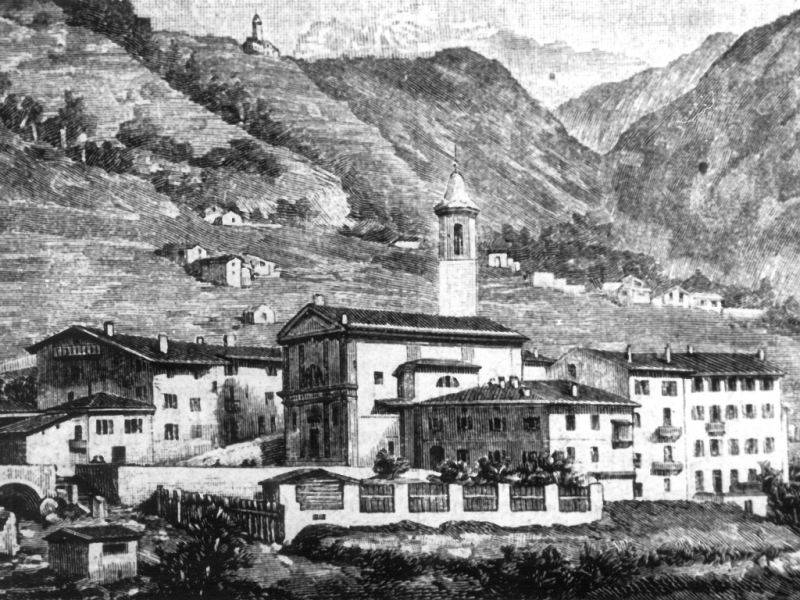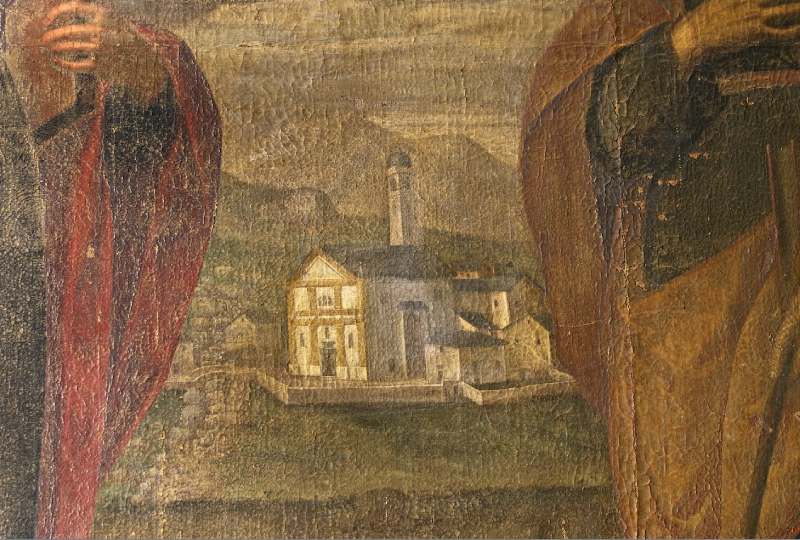di Saveria Masa
 An old postcard of Chiesa in Valmalenco.
An old postcard of Chiesa in Valmalenco.
The ancient church of San Giacomo, which later gave its name to the village of Chiesa, whichwas built and developed around it,
(Ecclesia de Malenco), was built around the 11th century by the Capitanei family of Sondrio, which also held feudal rights in the Valmalenco.
Throughout the 14th century, it was the only religious building in the valley where all the populations of the Valmalenco went to celebrate religious services.
The church was soon named after the two saints, Giacomo and Filippo.
It became the place where the heads of families and representatives of the
quadre (the valley communities) would meet to discuss civil and administrative matters.
Chiesa continued to be the civil and religious centre of the valley even when, in the 14th and 15th centuries, the other communities built their own churches.
Next to the church of the Saints Giacomo and Filippo lived the curate, who until the mid-sixteenth century was the only priest in the valley, and had the task of officiating at all the churches in the Valmalenco.
We have reason to believe that the priest's house in Chiesa also served as a temporary residence for the archpriests of Sondrio.
As they were also parish priests of the Valmalenco, they occasionally visited the valley to celebrate the more important festivities (such as the festivals of the patron saints) or to supervise the assets of the church.
A recent discovery made during the restoration of the old priest's house bears testimony to this, when it brought to light a remarkable fresco, depicting the coat of arms of the Andriani family.
Two of its members were archpriests of Sondrio (Giacomo e Giovanni Giacomo) and between the fifteenth and sixteenth century, they owned, amongst other things, numerous properties in the village of Chiesa.
In the second half of the 16th century, care of the souls in Chiesa became complicated, as difficult relationships arose with the protestant community, which had developed in the village.
At the head of the reformers was no other than the former Catholic curate, Bartolomeo Chiesa who, in 1555, recanted the Roman faith to pass over to the Reformed Church.
The state of crisis and decadence suffered in the local religious life involved all the valley communities.
It began to show signs of revival only from 1590 onwards, when the guidance of the parish of Sondrio (and, therefore, of the Valmalenco) was taken over by
Nicolò Rusca.
The work to reform the Catholic church, according to the principles of renewal dictated by The Council of Trento, was also carried out by the archpriest Rusca in the Valmalenco, with the help of a few highly motivated, zealous and theologically well-prepared priests.
In Chiesa, some important priests, such as Giovanni Cilichini (of Lanzada), Andrea Sasso (of Chiesa), Giovanni Tuana (of Grosotto) and Giovanni Pietro Carini (of Lanzada) followed on one after the other.
 The old church of the Saints Giacomo and Filippo, detail of the painting of the Madonna and the saints Giacomo and Filippo by Domenico Stella (1665).
The old church of the Saints Giacomo and Filippo, detail of the painting of the Madonna and the saints Giacomo and Filippo by Domenico Stella (1665).
After the sad story of the revolution in the Valtellina in 1620 (Holy Massacre), which drove all the protestants from the Valtellina, Chiesa, like the other communities in the valley, was also recognised as an autonomous parish by Sondrio.
The parish of the saints Giacomo and Filippo, formally established on 24 October 1624, was taken over by Giovanni Cilichini, formerly vice-curate from 1619 and subsequently in 1633, by Carlo Rusca (nephew of the archpriest
Nicolò Rusca).
Once the difficulties of having to live side by side with the protestants had been overcome and the local church had been renovated, the parish of Chiesa saw a significant increase in construction works over the 17th century, commencing with the imposing work to completely restore the parish church.
The outlying districts saw a discreet rise in their population and they needed to ensure religious services in situ.
This led to the construction of new churches: the church of St. Antonio di Padova was built in Vassalini in 1666-68, the Sanctuary of the Madonna delle Grazie in Primolo, the church of St. Anna in Chiareggio and the oratory of San Carlo were built in 1688.
Bibliography
-
Saveria Masa,
Una comunità e il suo santuario: storia e devozione, in
Francesca Bormetti – Saveria Masa,
Il santuario della Madonna delle Grazie di Primolo
, Sondrio 2007
-
Saveria Masa,
Fra curati cattolici e ministri riformati. Nicolò Rusca e il rinnovamento tridentino in Valmalenco,
Sondrio 2011
-
Gian Antonio Paravicini,
La pieve di Sondrio (a cura di Tarcisio Salice), Società Storica Valtellinese, Sondrio 1969
-
Tarcisio Salice,
Note sul “Castello di Malenco”, in
“Bollettino della Società Storica Valtellinese”,
No. 32 (1979), pp. 87-92